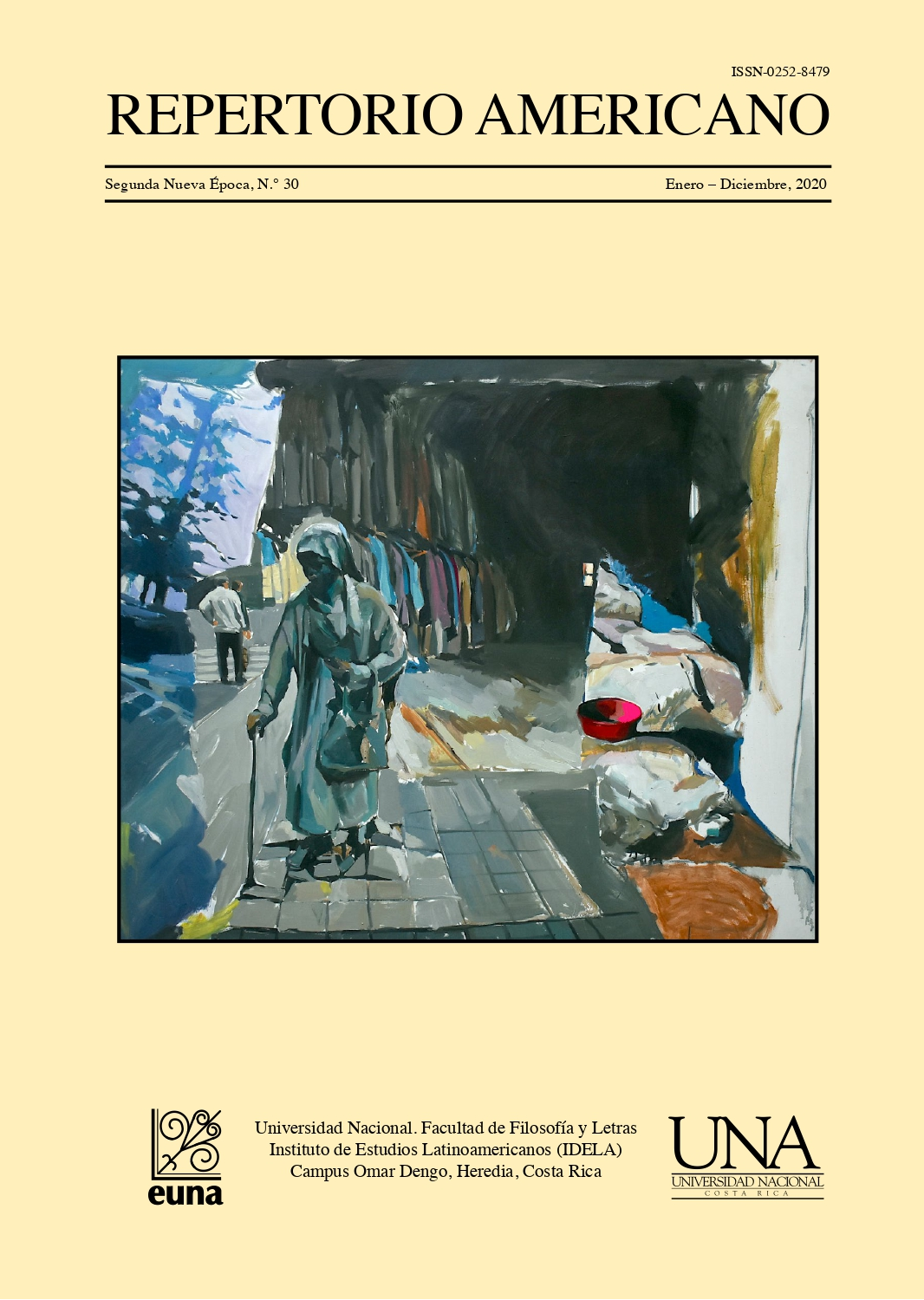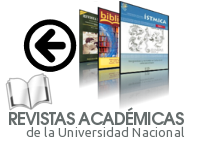Oposiciones binarias revisadas: la naturaleza y la reconciliación de los opuestos en El libro de las pesadillas de Kinnell
DOI:
https://doi.org/10.15359/ra.1-30.15Keywords:
US Literature, poetry, Jung, Campbell, binary oppositionAbstract
The book of nightmares, by Galway Kinnell, has been provided with a remarkable use of natural imagery that facilitates the understanding of the lifedeath binary opposition. These two apparently contradictory realms, life and death, are challenging to understand as elements of a unity, since many individuals, especially in Western society, have been taught to appreciate life and disregard death as a real and vital component of this duality. For the purpose of this study the Jungian archetypal approach and Campbell’s perspective on
myth will be discussed. Unquestionably, in this book-length poem, Kinnell succeeds in revealing their ancestral relationship through natural imagery; hence, the persona makes use of images like the rain, the stones of the path, as well as different kind of animals to craft a poetic world to which individuals can relate.
References
Achtemeier, P. ed. (1985). The HarperCollins Bible Dictionary. New York:
Harper Collins Publishers.
Adamski, S. (2011). Archetypes and the
collective unconscious of Carl
G. Jung in the light of quantum
psychology. NeuroQuantology, 9
(3), 563-571. Retrieved from http://
citeseerx.ist.psu.edu/viewdoc/down
load?doi=10.1.1.921.5519&rep=re
p1&type=pdf
Barthes, R. (1977). Ensayos críticos. Barcelona: Editorial Seix Barral.
Barthes, R. (1999). Mythologies. New
York: Hill and Wang.
Biedermann, H. (1992). Dictionary of
symbolism (J. Hulbert, Trans.) New
York: Facts on File. (Original work
published in 1989).
Bodkin. M. (1951). Archetypal patterns in
poetry. London: Oxford University
Press.
Bourdieu, P. (1991). Language and symbolic power. Ed. and Intro. John B.
Thompson. (Raymond, G. & Admason, M., Trans). Massachusets:
Harvard University Press.
Calhoun, R. (1992). Galway Kinnell. New
York: Twayne Publishers.
Campbell, J. (1972). Myths to live by. New
York: The Viking Press.
Campbell, J. (1991). The power of myth.
New York: Anchor Books.
Campbell, J. (2004a). Pathways to bliss.
California: New World Library.
Campbell, J. (2004b). The hero with a
thousand faces. Boston: Princeton
University Press.
Cirlot, J.C. (1962). A Dictionary of symbols. London: Routledge.
Cuddon, J. A. (1976). A Dictionary of literary terms. Middlesex: Penguin
Books.
DeNiord, C., & Kinnell, G. (2011). An interview with Galway Kinnell. The
American Poetry Review, 40(1),
-11. Retrieved from http://www.
jstor.org/stable/23053002
Dundes, A. (1997). Binary opposition in
myth: The Propp/Lévi-Strauss debate in retrospect. Western Folklore,
(1), 39-50. doi:10.2307/1500385
Eagleton, T. (1996). Literary theory: An
introduction. Massachusetts: Blackwell Publishing.
Edelman, S. P. (1981). The poet as healer.
Southwest Review, 66(2), 215–219.
Retrieved from: JSTOR, www.jstor.
org/stable/43469347.
Edinger, E. (1992). Ego and archetype.
Massachusetts: Shambhala Publications, Inc.
Ferber, M. (1999). A dictionary of literary
symbols. Cambridge: Cambridge
University Press.
García, A. A. (2010). “In the Shadow of
a Mosque: Mapping the “Song
of Roland”.” The French Review,
(2), 311-25. http://www.jstor.
org.ezproxy.sibdi.ucr.ac.cr:2048/
stable/25758409.
Gardner, T., & Kinnell, G. (1979). An
interview with Galway Kinnell.
Contemporary Literature, 20(4),
-433. doi:10.2307/1207901
Gross, H. (1974). The problem of style
and the poetry of the sixties. The
Iowa Review, 5(1), 69-74. Retrieved from http://www.jstor.org/
stable/20158188
Henderson, J. L. (1995). Reflections on
the history and practice of Jungian
analysis. In M. Stein, ed., Jungian
analysis (2nd ed.). Chicago and La
Salle, IL: Open Court. pp. 10-15.
Hyman, S. (1955). The ritual view of myth
and the mythic. The Journal of
American Folklore, 68(270), 462-
doi:10.2307/53677.
Jung. C. G. (1959). The archetypes and
the collective unconscious. London:
Routledge & Kegan Paul.
Jung, C. G. (1964). Man and his symbols.
New York: Dell Publishing Co., Inc.
Jung, C. G. (1961). Memories, dreams, reflections. New York: Pantheon.
Jung, C. G. (1970). Four archetypes. Boston: Princeton University Press.
Jung, C. G. (2006). The undiscovered self. New York: A Signet Book.
Jung, C.G. (2010). Modern man in search
of a soul. New York: Hartcourt, Inc.
Kinnell, G., Gerber, P., Gemmett, R.,
Gerald, G., & Heyen, W. (1970).
“Deeper than Personality”: A Conversation with Galway Kinnell. The
Iowa Review, 1(2), 125-133. Retrieved from http://www.jstor.org/
stable/20157582
Kinnell, G. (1971a). The book of nightmares. Boston: Houghton Mifflin
Company
Kinnell, G. (1971b). The poetics of the
physical world. The Iowa Review,
(3), 103-126. Retrieved from
https://ir.uiowa.edu/cgi/viewcontent.cgi?article=1251&context=iow
areview
Kinnell, G. (1978). Walking down the
stairs: Selections from interviews.
Michigan: The University of Michigan Press.
Kinnell, G., & McKenzie, J. (1973). To
the roots: an interview with Galway
Kinnell. Salmagundi, 22/23, 206-
Retrieved from http://www.
jstor.org/stable/40546780
Kinnell, G., Poulin, A., & Rubin, S.
(1976). Interview with A. Poulin, Jr.
and Stan Samuel Rubin. The American Poetry Review, 5(4), 6-7. Retrieved from http://www.jstor.org/
stable/27775318
Kleinbard, D. (1986). Galway Kinnell’s
poetry of transformation. The Centennial Review, 30(1), 41-56. Retrieved from http://www.jstor.org/
stable/23738612
Lévi-Strauss, C. (1955). The structural
study of myth. The Journal of American Folklore, 68(270), 428-444.
doi:10.2307/536768
Lévi-Strauss, C. (1978). Myth and meaning. London: Routledge and Kegan Paul.
Mackey, L. (1981). Anatomical curiosities: Northrop Frye’s theory of criticism. Texas Studies in Literature
and Language, 23(3), 442-469.
Retrieved from http://www.jstor.
org.ezproxy.sibdi.ucr.ac.cr:2048/
stable/40754656
MacShane, F. (1968). Of writing and
writers: The new poetry. The American Scholar, 37(4), 642-646. Retrieved from http://www.jstor.org/
stable/41209609
Malamud, R. (2000). The culture of
using animals in literature and
the case of Jose Emilio Pacheco.
CLCWeb: Comparative Literature and Culture 2.2: https://doi.
org//10.771/1481-4374.1072
Marcello, L. L. (1976). Galway Kinnell:
Adamic poet and deep imagist.
Available from ProQuest Dissertations & Theses A&I. (288265041).
Retrieved from http://search.proquest.com/docview/288265041?ac
countid=32236
Mills, R.J., Jr. (1970a). A reading of Galway Kinnell. The Iowa Review,1(1),
-86. Retrieved from http://www.
jstor.org/stable/20157537
Mills, R.J., Jr. (1970b). A reading of Galway Kinnell: Part 2 (Continued).
The Iowa Review, 1(2), 102-122.
Retrieved from http://www.jstor.
org/stable/20157579
Mills, R. J., Jr. (1975). Cry of the human
essays on contemporary American
poetry. Chicago: University of Illinois Press.
Nandi, R. (2016). Archetypal approach
to Eliot’s “The Wasteland.” An Interdisciplinary Journal of Literary
Studies, 1(1), 57-66. Retrieved
from http://postscriptum.co.in/wpcontent/uploads/2016/09/RINKUNANDI.pdf
Nelson, H. (1987). On the poetry of Galway Kinnell. Michigan: The University of Michigan Press.
Pagel, W. (1948). Jung’s views on Alchemy. Isis, 39(1/2), 44-48. Retrieved
from http://www.jstor.org.ezproxy.
sibdi.ucr.ac.cr:2048/stable/226767.
Paz, O. (1995). El laberinto de la soledad.
Madrid: Ediciones Cátedra.
Rosenthal, M.L. & Gall, S. M. (1983). The
modern poetic sequence. Oxford:
Oxford University Press.
Rowland, S. (1999). C.G. Jung and literary theory: The challenge from fiction. New York: St. Martin’s Press.
Sabini, M., ed., (2001). C.G. Jung. The
earth has a soul: Jung on nature,
technology & modern life. (1st ed).
California: North Atlantic Books.
Selden, R. (1989). Practicing theory and
reading literature. Kentucky: The
University Press of Kentucky.
Selden, R. & Widdowson, P. (1993). A
reader’s guide to contemporary literary theory. Kentucky: The University Press of Kentucky.
Scheffler, T. (1981). The ideology of binary opposition: Subject/object
duality and anthropology. Dialectical Anthropology, 6(2), 165-169.
Retrieved from http://www.jstor.
org.ezproxy.sibdi.ucr.ac.cr:2048/
stable/29790030
Storr, A. (1989). The essential Jung. Boston: Princeton University Press.
Sugg, R., eds. (1992). Jungian Literary
Criticism. Evanston, Illinois: Northwestern University Press.
Taha, A. (n.d.) The allegorical use of
the rituals of hunting in Galway
Kinnell’s “The Bear”. (n.ed.). Retrieved from:http://www.iasj.net/
iasj?func=fulltext&aId=81622
The Poetry of Galway Kinnell. Literary
Cavalcade, 53(1), 2000, 16-18. Retrieved from http://search.proquest.
com/docview/210471429?account
id=32236
Toskar, S. (1981). Galway Kinnell’s
The book of nightmares: The
wages of dying is love. Hokusei Gakuen University, 19, 361-
Retrieved from https://ci.nii.
ac.jp/els/contents110000338332.
pdf?id=ART0000775706
Townsend, D. (1972). Myth and meaning. The Centennial Review, 16(2),
-202. Retrieved from http://
www.jstor.org.ezproxy.sibdi.ucr.
ac.cr:2048/stable/23738355
Tuten, N. (1992). The language of sexuality: Walt Whitman and Galway Kinnell. Walt Whitman
Quarterly Review, 9, 134-141.
Retrieved from http://dx.doi.
org/10.13008/2153-3695.1325
Tuten, N. (1996). Critical essays on Galway Kinnell. New York: G.K. Hall
&Co.
Zimmerman, L. (1987). The poetry of Galway Kinnell. Chicago: University
of Illinois Press.
Published
How to Cite
Issue
Section
License
Las cartas de entendimiento se facilitarán a las personas autoras al momento de aceptación de su trabajo para publicarse.
Todos los contenidos son de libre acceso con sólo citar la fuente.







